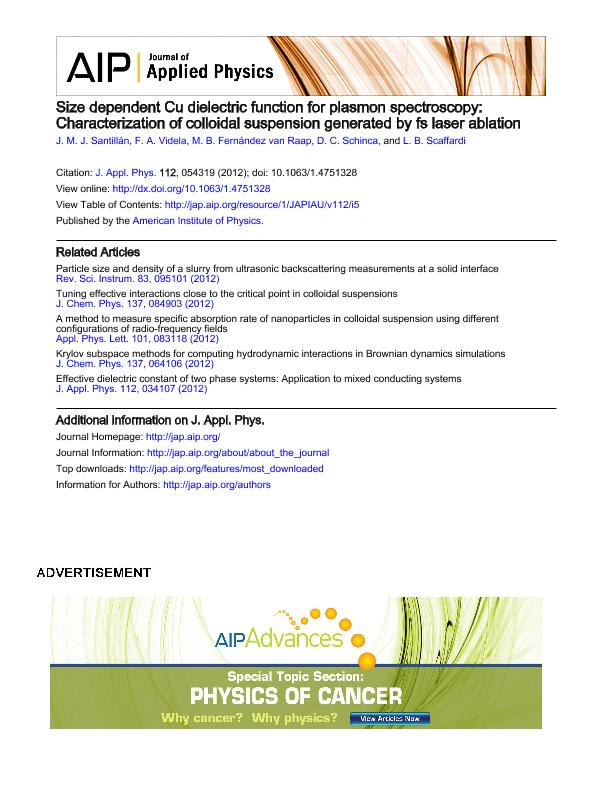Mostrar el registro sencillo del ítem
dc.contributor.author
Santillán, Jesica María José

dc.contributor.author
Videla, Fabian Alfredo

dc.contributor.author
Fernández van Raap, Marcela Beatriz

dc.contributor.author
Schinca, Daniel Carlos

dc.contributor.author
Scaffardi, Lucia Beatriz

dc.date.available
2020-03-21T12:43:53Z
dc.date.issued
2012-09-10
dc.identifier.citation
Santillán, Jesica María José; Videla, Fabian Alfredo; Fernández van Raap, Marcela Beatriz; Schinca, Daniel Carlos; Scaffardi, Lucia Beatriz; Size dependent Cu dielectric function for plasmon spectroscopy: Characterization of colloidal suspension generated by fs laser ablation; American Institute of Physics; Journal of Applied Physics; 112; 10-9-2012; 1-9
dc.identifier.issn
0021-8979
dc.identifier.uri
http://hdl.handle.net/11336/100575
dc.description.abstract
Copper metal nanoparticles (Nps) have received increasing interest during the last years due to their potential applications in several fields of science and technology. Their optical properties depend on the characteristics of the dielectric function of the metal, their size, and the type of environment. The contribution of free and bound electrons on the dielectric function of copper Nps is analyzed as well as their influence on its plasmonic properties. The contribution of free electrons is corrected for particle size under 10 nm, introducing a term inversely proportional to the particle's radius in the damping constant. For bound electron contribution, interband transitions from the d-band to the conduction band are considered. For particles with sizes below 2 nm, the larger spacing between electronic energy levels must be taken into account by making the electronic density of states in the conduction band size-dependent. Considering these specific modifications, optical parameters and band energy values could be determined by fitting the bulk complex dielectric function. The obtained values were coefficient for bound electron contribution Kbulk = 2 × 1024, gap energy Eg = 1.95 eV, Fermi energy EF = 2.15 eV, and bound electrons damping constant γb = 1.15 × 1014 Hz. Based on the dielectric function determined in this way, experimental extinction spectra of colloid suspensions generated by ultrafast laser ablation of a solid copper target in liquids was fitted using the Drude-interband model and Mie's theory. Depending on the experimental conditions and liquid medium, the particles in the suspension may have nanometric or subnanometric core size and may be capped with a shell of oxide. From the fitting, it was possible to determine the structure and size distribution of spherical bare core and core-shell copper Nps in the nanometer-subnanometer size range. These results were compared with those obtained by standard microscopy techniques such as AFM and HRTEM. There is a very good agreement between the three techniques, showing that optical extinction spectroscopy (OES) is a good complementary technique to standard high resolution electron microscopy and AFM for sizing spherical nanometric-subnanometric Nps. OES has also the advantage of a very good measurement statistics, due to the large number of probed particles across the sample cell. Besides, it avoids coalescence effects since the measurement is made directly on the colloidal suspension.
dc.format
application/pdf
dc.language.iso
eng
dc.publisher
American Institute of Physics

dc.rights
info:eu-repo/semantics/openAccess
dc.rights.uri
https://creativecommons.org/licenses/by-nc-sa/2.5/ar/
dc.subject
OPTICAL EXTINCTION SPECTROSCOPY
dc.subject
OPTICAL PROPERTIES
dc.subject
BOUND STATES
dc.subject
OXIDES
dc.subject.classification
Óptica

dc.subject.classification
Ciencias Físicas

dc.subject.classification
CIENCIAS NATURALES Y EXACTAS

dc.title
Size dependent Cu dielectric function for plasmon spectroscopy: Characterization of colloidal suspension generated by fs laser ablation
dc.type
info:eu-repo/semantics/article
dc.type
info:ar-repo/semantics/artículo
dc.type
info:eu-repo/semantics/publishedVersion
dc.date.updated
2020-03-16T14:59:50Z
dc.journal.volume
112
dc.journal.pagination
1-9
dc.journal.pais
Estados Unidos

dc.journal.ciudad
New York
dc.description.fil
Fil: Santillán, Jesica María José. Consejo Nacional de Investigaciones Científicas y Técnicas. Centro Científico Tecnológico Conicet - La Plata. Centro de Investigaciones Ópticas. Provincia de Buenos Aires. Gobernación. Comisión de Investigaciones Científicas. Centro de Investigaciones Ópticas. Universidad Nacional de La Plata. Centro de Investigaciones Ópticas; Argentina
dc.description.fil
Fil: Videla, Fabian Alfredo. Consejo Nacional de Investigaciones Científicas y Técnicas. Centro Científico Tecnológico Conicet - La Plata. Centro de Investigaciones Ópticas. Provincia de Buenos Aires. Gobernación. Comisión de Investigaciones Científicas. Centro de Investigaciones Ópticas. Universidad Nacional de La Plata. Centro de Investigaciones Ópticas; Argentina
dc.description.fil
Fil: Fernández van Raap, Marcela Beatriz. Consejo Nacional de Investigaciones Científicas y Técnicas. Centro Científico Tecnológico Conicet - La Plata. Instituto de Física La Plata. Universidad Nacional de La Plata. Facultad de Ciencias Exactas. Instituto de Física La Plata; Argentina
dc.description.fil
Fil: Schinca, Daniel Carlos. Consejo Nacional de Investigaciones Científicas y Técnicas. Centro Científico Tecnológico Conicet - La Plata. Centro de Investigaciones Ópticas. Provincia de Buenos Aires. Gobernación. Comisión de Investigaciones Científicas. Centro de Investigaciones Ópticas. Universidad Nacional de La Plata. Centro de Investigaciones Ópticas; Argentina
dc.description.fil
Fil: Scaffardi, Lucia Beatriz. Consejo Nacional de Investigaciones Científicas y Técnicas. Centro Científico Tecnológico Conicet - La Plata. Centro de Investigaciones Ópticas. Provincia de Buenos Aires. Gobernación. Comisión de Investigaciones Científicas. Centro de Investigaciones Ópticas. Universidad Nacional de La Plata. Centro de Investigaciones Ópticas; Argentina
dc.journal.title
Journal of Applied Physics

dc.relation.alternativeid
info:eu-repo/semantics/altIdentifier/url/https://aip.scitation.org/doi/10.1063/1.4751328
dc.relation.alternativeid
info:eu-repo/semantics/altIdentifier/doi/http://dx.doi.org/10.1063/1.4751328
Archivos asociados
